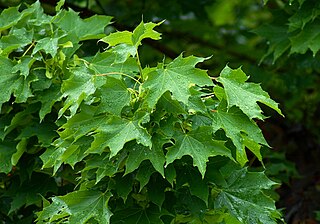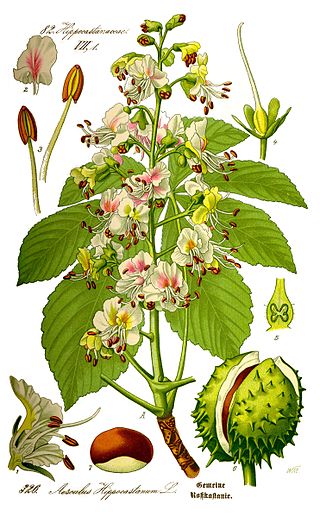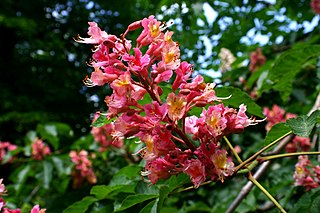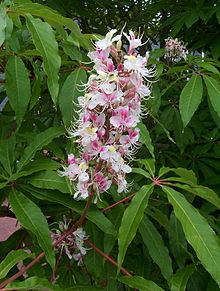
Azadirachta indica, commonly known as neem, margosa, nimtree or Indian lilac, is a tree in the mahogany family Meliaceae. It is one of two species in the genus Azadirachta. It is native to the Indian subcontinent and to parts of Southeast Asia, but is naturalized and grown around the world in tropical and subtropical areas. Its fruits and seeds are the source of neem oil. Nim is a Hindustani noun derived from Sanskrit nimba (निंब).

Acer platanoides, commonly known as the Norway maple, is a species of maple native to eastern and central Europe and western Asia, from Spain east to Russia, north to southern Scandinavia and southeast to northern Iran. It was introduced to North America in the mid-1700s as a shade tree. It is a member of the family Sapindaceae.

Tamarind is a leguminous tree bearing edible fruit that is indigenous to tropical Africa and naturalized in Asia. The genus Tamarindus is monotypic, meaning that it contains only this species. It belongs to the family Fabaceae.

Acer campestre, known as the field maple, is a flowering plant species in the family Sapindaceae. It is native to much of continental Europe, Britain, southwest Asia from Turkey to the Caucasus, and north Africa in the Atlas Mountains. It has been widely planted, and is introduced outside its native range in Europe and areas of USA and Western Australia with suitable climate.

Aesculus pavia, known as red buckeye or firecracker plant, is a species of deciduous flowering plant. The small tree or shrub is native to the southern and eastern parts of the United States, found from Illinois to Virginia in the north and from Texas to Florida in the south. It is hardy far to the north of its native range, with successful cultivation poleward to Arboretum Mustila in Finland.

The genus Aesculus, with species called buckeye and horse chestnut, comprises 13–19 species of flowering plants in the family Sapindaceae. They are trees and shrubs native to the temperate Northern Hemisphere, with six species native to North America and seven to 13 species native to Eurasia. Several hybrids occur. Aesculus exhibits a classical Arcto-Tertiary distribution.

Aesculus hippocastanum, the horse chestnut, is a species of flowering plant in the maple, soapberry and lychee family Sapindaceae. It is a large, deciduous, synoecious (hermaphroditic-flowered) tree. It is also called horse-chestnut, European horsechestnut, buckeye, and conker tree. It is not to be confused with the Spanish chestnut, Castanea sativa, which is a tree in another family, Fagaceae.

Aesculus glabra, commonly known as Ohio buckeye, Texas buckeye, fetid buckeye, and horse chestnut is a species of tree in the soapberry family (Sapindaceae) native to North America.

Aesculus flava, also known commonly as the common buckeye, the sweet buckeye, and the yellow buckeye, is a species of deciduous tree in the subfamily Hippocastanoideae of the family Sapindaceae. The species is native to the Ohio Valley and Appalachian Mountains of the Eastern United States. It grows in mesophytic forest or floodplains, generally in acid to circumneutral soil, reaching a height of 20m to 48m.

Larix kaempferi, the Japanese larch or karamatsu in Japanese, is a species of larch native to Japan, in the mountains of Chūbu and Kantō regions in central Honshū.

Aesculus californica, commonly known as the California buckeye or California horse-chestnut, is a species of buckeye native to California and southwestern Oregon.

Acer is a genus of trees and shrubs commonly known as maples. The genus is placed in the soapberry family, Sapindaceae, along with lychee and horse chestnut. There are approximately 132 species, most of which are native to Asia, with a number also appearing in Europe, northern Africa, and North America. Only one species, Acer laurinum, extends to the Southern Hemisphere. The type species of the genus is the sycamore maple, Acer pseudoplatanus, the most common maple species in Europe. Maples usually have easily recognizable palmate leaves and distinctive winged fruits. The closest relatives of the maples are the horse chestnuts. Maple syrup is made from the sap of some maple species. It is one of the most common genera of trees in Asia. Many maple species are grown in gardens where they are valued for their autumn colour.

Pachira aquatica is a tropical wetland tree in the mallow family Malvaceae, native to Central and South America where it grows in swamps. It is known by its common names Malabar chestnut, French peanut, Guiana chestnut, Provision tree, Saba nut, Monguba (Brazil), Pumpo (Guatemala) and is commercially sold under the names Money tree and Money plant. This tree is sometimes sold with a braided trunk and is commonly grown as a houseplant, although more commonly what is sold as a "Pachira aquatica" houseplant is in fact a similar species, P. glabra.

Adenium obesum, more commonly known as a desert rose, is a poisonous species of flowering plant belonging to the tribe Nerieae of the subfamily Apocynoideae of the dogbane family, Apocynaceae. It is native to the Sahel regions south of the Sahara, tropical and subtropical eastern and southern Africa and also the Arabian Peninsula. Other names for the flower include Sabi star, kudu, mock azalea, and impala lily. Adenium obesum is a popular houseplant and bonsai in temperate regions.

Aesculus × carnea, or red horse-chestnut, is a medium-sized tree, an artificial hybrid between A. pavia and A. hippocastanum (horse-chestnut). Its origin uncertain, probably appearing in Germany before 1820. It is a popular tree in large gardens and parks.

The National Arboretum Canberra is a 250-hectare (620-acre) arboretum in Canberra, the national capital of Australia, created after the area was burned out as a result of the Christmas 2001 and 2003 Canberra bushfires: The Himalayan Cedar forest lost about one third of its trees, and the commercial Radiata Pine plantation was burned out, allowing the arboretum to be created.

Pyrus pashia, the wild Himalayan pear, is a small to medium size deciduous tree of the small and oval shaped crown with ovate, finely toothed leaves, attractive white flowers with red anthers and small pear-like fruits. It is a fruit bearing tree that is native to southern Asia. Locally, it is known by many names such as batangi (Urdu), tangi (Kashmiri), mahal mol (Hindi) and passi (Nepal).

Aesculus chinensis, the Chinese horse chestnut or Chinese buckeye, is a deciduous temperate tree species in the genus Aesculus found across China. It was first successfully introduced to Britain in 1912 by plant collector William Purdom, who collected six young plants from the grounds of a temple in the western hills of Beijing, and brought them back to Veitch's Nursery in Coombe Hill near London. Purdom's correspondence regarding this event are held in the archives of the Arnold Arboretum. One plant was sent to the Royal Botanic Gardens Kew and two to the Arnold Arboretum in Boston. The original tree at Kew no longer exists but a young tree grafted from the original now grows in the Rhododendron Dell.

Fraxinus floribunda is a species of ash native to South Asia, East Asia, and Southeast Asia. It is known from Afghanistan, Pakistan, Nepal, Assam, Bhutan, Laos, Myanmar (Burma), Thailand, Vietnam, the Ryukyu Islands, and parts of China.

Quercus leucotrichophora is a tree belonging to Family Fagaceae; commonly known as Banjh oak, Banj oak (Uttarakhand) and Ban oak (Himachal). In Nepal, it is known as Banjhi, Rainj, Khasarant, Tikhe bhanjh in standard Nepali and Sulsing in Tamang language. It is classified in subgenus Cerris, section Ilex. Some authors named it as Quercus incana Roxburgh, which is now treated as a synonym.






















